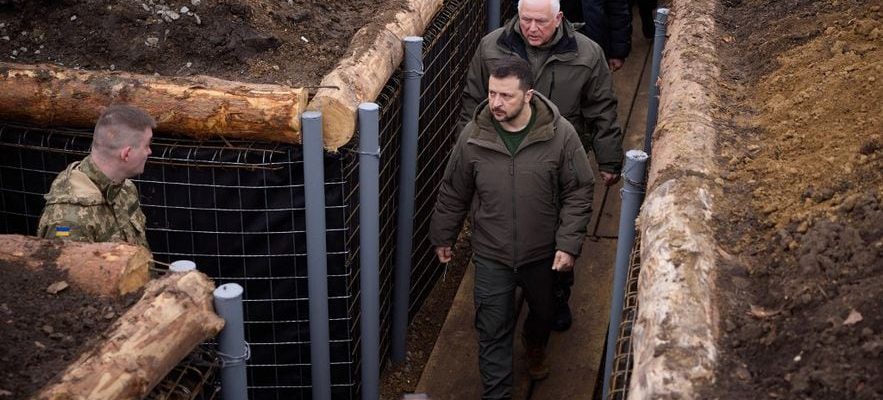With the arrival of good weather in Ukraine, fears are growing that Russian troops will carry out another major assault on the front. In order to be able to repel it, thanks to the drying out of the soil after the sludge from the Rasputitsa, Volodymyr Zelensky announced in mid-March the construction of 2000 kilometers of fortifications, made up of three lines of defense. Two weeks later, the Ukrainian president even put on his construction manager’s clothes. “I inspected trenches, shelters, firing, command and observation posts. We are strengthening our defenses,” he said on Telegramon March 27, after a visit to ongoing works in the Sumy region, northern Ukraine.
“The Russians did this work last year with their Sourovikin line, the construction of which partly explained the failure of the Ukrainian counter-offensive,” underlines General Jérôme Pellistrandi, editor-in-chief of the National Defense Magazine. Today, the Ukrainians want to do the same thing urgently to prevent them from encroaching on their territory.” According to Ukrainian Prime Minister Denys Shmyhal, more than 710 million euros had already been allocated for construction by mid -FEBRUARY.
The shortage of ammunition in the Ukrainian camp – in a context of persistent blockage of aid to Washington – could encourage Russian forces to step up their offensive. “The window of opportunity is now, and the Russians know it,” says General Nicolas Richoux, former commander of the 7th Armored Brigade. Ultimately, the rise in power of the Western defense industry will end up making it more difficult for them task.”
The whole challenge for the Ukrainian forces is to manage to absorb the shock. After pleading in January for an “active defense” strategy, aimed at holding its positions while inflicting maximum losses on the enemy, the former commander of the Ukrainian land forces, now head of the armed forces , Oleksandr Syrsky, assured at the end of March that the construction of fortifications was now “one of the priorities” both at the top of the state and in the army.
Ukrainian President Volodymyr Zelensky walking along the trenches, in the Sumy region, March 27, 2024.
© / AFP
Accelerate construction
Across the entire front line, Ukrainian forces are today busy digging trenches and anti-tank ditches, to which are added casemates, minefields and “dragon’s teeth” (concrete cones loaded with to slow down the advance of the armored vehicles). “Each line of defense is preceded by mines and obstacles to slow down the enemy’s progress,” explains General Pellistrandi. “This allows the defender to inflict maximum losses with his artillery thanks to previously established firing plans. ” An effective way to resist attacks while saving men and ammunition. “Depth is designed to wear down the adversary,” adds General Richoux. “You exhaust the enemy on the first line of defense, you break them on the second and you prevent them from passing the third.”
The challenge today is to speed up construction work. Although a working group had been created in November at the request of Volodymyr Zelensky to coordinate their implementation along the front, the work only really intensified three months later. “There was a delay,” observes General Pellistrandi. “The defensive pivot has really intensified since the former head of the army Valery Zaloujny was replaced by Oleksandr Sysrsky in mid-February.” After the fall of Avdiivka on February 17, Russian forces managed to gradually continue their advance westward, raising questions about the strength of Ukrainian defenses in the area. On April 5, Moscow claimed the capture of the village of Vodiané, approximately 6 kilometers southwest of Avdiivka.
Can Ukraine’s defenses be ready in time? “In 2023, the Russians built theirs in haste and nevertheless managed to set up a very impressive fortified system, notes General Richoux. If kyiv manages to successfully complete its fortifications, the Russians will have just as much difficulty in break through than the Ukrainians last year.” Enough to predict heavy losses in the event of an offensive. During the recent assault by a tank battalion on March 30 near the village of Tonenke, in the Donetsk region, Russian forces have already lost no less than 12 tanks and 8 armored vehicles. Without succeeding in breaking through.
.
